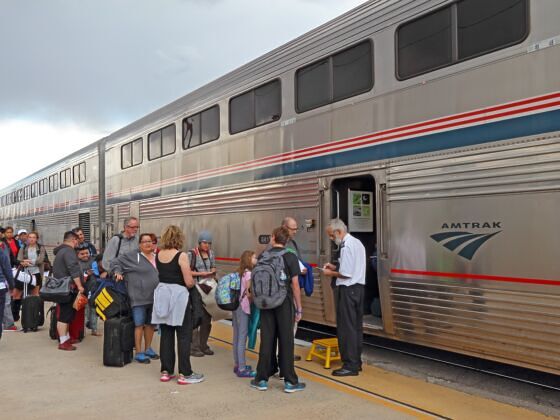This summer, as I was on an epic rail trip through France, Belgium, and Germany, I had to deal with some train delays. On the 4.5-hour ride from Cologne to Berlin, we were 15 minutes late and I was fuming. I had a tight connection and knew that would have to dash across Berlin’s central station to catch my next train. Luckily, my connecting ride was also late, by 10 minutes, so I made it with plenty of time.

Freight Trains Caused the Equivalent of 1.5 Years of Delay to Amtrak Trains in 2023 Alone
Delayed trains is a very common occurrence these days in Germany, and because of the lack of punctuality, the Deutsche Bahn, Germany’s national railway operator, is even referred to as a “national embarrassment“. But if the Deutsche Bahn’s punctuality performance statistics for 2023 are correct, there’s very little to be embarrassed about: on average, 90.1 percent of the rail traffic is on time.
One thing is for sure: Compared to Amtrak’s records, Deutsche Bahn is a role model for punctuality. In 2023, all 15 of Amtrak’s long-distance routes, and 15 of the 24 state-supported routes, failed to meet the Federal Railroad Administration’s punctuality standard. That means that only nine of the 39 Amtrak routes were able to get 80 percent or more of their customers to their destinations within 15 minutes of the scheduled time.
In 2023, the routes the most affected by delays were the California Zephyr (Chicago-San Francisco), the Southwest Chief (Chicago-Los Angeles), and the Sunset Limited (New Orleans-Los Angeles), all long-distance journeys. Only 33 percent of the passengers on the California Zephyr got to their destinations on time, 34 percent of the passengers on the Southwest Chief, and 44 percent of the passengers on the Sunset Limited.
While there are many reasons why Amtrak trains are delayed, including weather, track maintenance, and mechanical issues, the most common of all of them is freight train interference.
Freight train interference is a big thorn in Amtrak’s side
Far from being responsible for freight train interference, Amtrak is a victim. Freight trains, which are slower than Amtrak’s trains, are required by federal law to give priority to passenger trains, but freight railroads, who own and maintain most the tracks used by Amtrak outside of the Northeastern Corridor, entirely disregard the rule. By prioritizing freight trains on their own tracks, freight railroads create major delays for Amtrak. In 2023 alone, freight trains getting in the way of Amtrak trains caused a total delay of 900,000 minutes, the equivalent of 1.5 years.
Because most of the railways tracks in the Northeastern Corridor are owned and maintained by Amtrak, the routes operating on those tracks are more punctual. The Keystone route (New York-Harrisburg) was the most punctual of all the Amtrak routes in 2023 with 94 percent of the passengers getting to their destination on time.
To get the freight railroads to abide to the law, Amtrak asks of its customers that they reach out to their members of Congress and complain about the issue so that legislation is finally enforced.
Amtrak’s communication and compensation for delays
To keep its customer apprised of schedule changes or cancelations, Amtrak sends email and text updates, displays delays on screens and makes announcements in train stations and onboard trains. When cancelations and significant delays happen, Amtrak customer service members reach out directly to passengers to provide accommodation and compensation in the forms of refunds, vouchers, or rewards points. Passengers can also reach Amtrak directly by texting 268725 (AMTRAK) or calling 1-800-USA RAIL (1-800-872-7245).